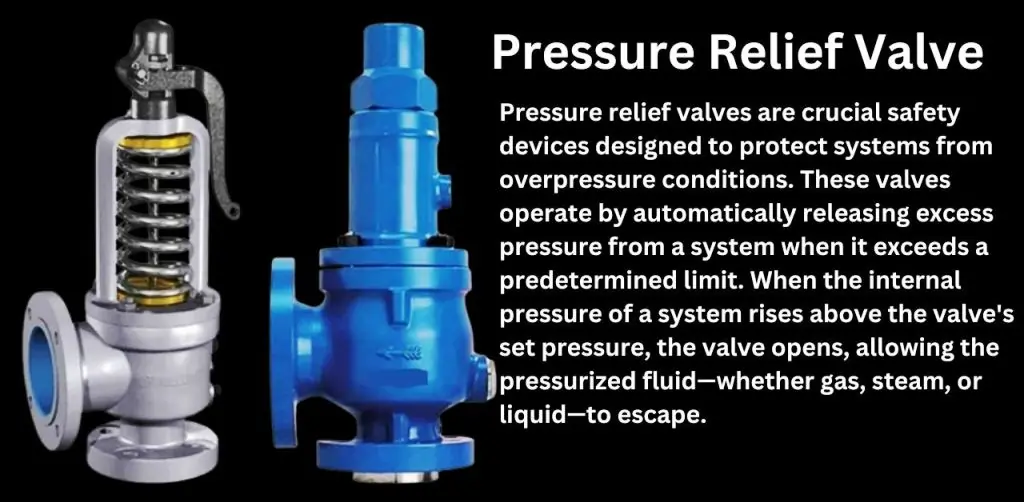Pressure Relief Valve
Pressure relief valves are essential in maintaining the safety and efficiency of high-pressure systems across various industries, including marine machinery. In marine environments, these valves are critical for preventing overpressure in equipment such as compressors, boilers, and hydraulic systems. They ensure that the machinery operates within safe limits, protecting both the equipment and the crew from potential hazards like explosions or mechanical failures.
Given their crucial role, a thorough understanding of pressure relief valves is vital for anyone involved in maintaining marine machinery. This post will cover the seven most critical insights into pressure relief valves, offering key knowledge on design, installation, and maintenance. Whether you’re working with marine compressors or other high-pressure systems, these insights will enhance your ability to keep operations safe, efficient, and compliant with industry standards.
Understanding Pressure Relief Valves
Basic Operation
Pressure relief valves are crucial safety devices designed to protect systems from overpressure conditions. These valves operate by automatically releasing excess pressure from a system when it exceeds a predetermined limit. When the internal pressure of a system rises above the valve’s set pressure, the valve opens, allowing the pressurized fluid—whether gas, steam, or liquid—to escape. This release of pressure prevents potential damage to equipment, such as ruptures, explosions, or mechanical failures. Once the pressure returns to safe levels, the valve closes, sealing the system and restoring normal operation. The simplicity and reliability of this mechanism make pressure relief valves indispensable in many high-pressure systems.
Importance in Various Industries
Pressure relief valves play a vital role in several industries where controlling pressure is essential for safety and efficiency. In the oil and gas industry, these valves are used to protect pipelines, storage tanks, and processing equipment from dangerous overpressure scenarios. In chemical processing, pressure relief valves prevent the buildup of pressure that could lead to chemical spills, fires, or explosions, safeguarding both the facility and the environment. In HVAC (Heating, Ventilation, and Air Conditioning) systems, these valves ensure that boilers and refrigeration units operate safely by preventing pressure from exceeding safe operating limits. Across these and other industries, pressure relief valves are critical components that help maintain the safety, efficiency, and reliability of complex systems.
Key Design Considerations for Pressure Relief Valves
Material Selection
Selecting the appropriate materials for pressure relief valves is critical to ensuring their durability and reliability in various applications. The material chosen must withstand the specific operating conditions of the system, including temperature, pressure, and the type of fluid being controlled. For example, in corrosive environments such as chemical processing plants, valves made from stainless steel or other corrosion-resistant alloys are essential to prevent degradation over time. In contrast, for high-temperature applications, materials like Inconel or Hastelloy may be preferred due to their ability to maintain strength at elevated temperatures. The right material selection not only enhances the valve’s lifespan but also ensures consistent performance under challenging conditions, preventing potential failures that could compromise system safety.
Size and Set Pressure
Determining the correct size and set pressure for a pressure relief valve is crucial for optimal performance. The valve must be appropriately sized to handle the maximum expected flow rate of the fluid while maintaining the system’s pressure within safe limits. The set pressure is the point at which the valve will open to release excess pressure, and it must be carefully calculated based on the system’s operating conditions.
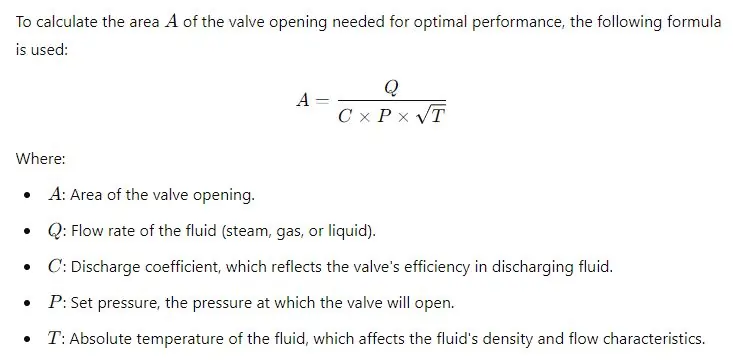
This formula helps engineers and designers ensure that the pressure relief valve is properly sized to handle the specific demands of the system, thereby preventing overpressure conditions and ensuring safe, efficient operation. The correct sizing and pressure setting are vital to avoiding unnecessary valve activation and ensuring the system remains within its designed operational parameters.
Common Types of Pressure Relief Valves
Spring-Loaded Valves

Spring-loaded pressure relief valves are among the most widely used types of relief valves in various industries. These valves operate using a spring mechanism that holds the valve closed until the system pressure exceeds the pre-set limit. When the pressure reaches this threshold, the force exerted by the fluid overcomes the spring tension, causing the valve to open and release the excess pressure. Once the pressure drops back to safe levels, the spring closes the valve, restoring the system to normal operation. The primary benefits of spring-loaded valves include their simplicity, reliability, and ease of maintenance. They are commonly used in applications such as steam systems, air compressors, and liquid storage tanks, where they provide effective and consistent pressure control.
Pilot-Operated Valves
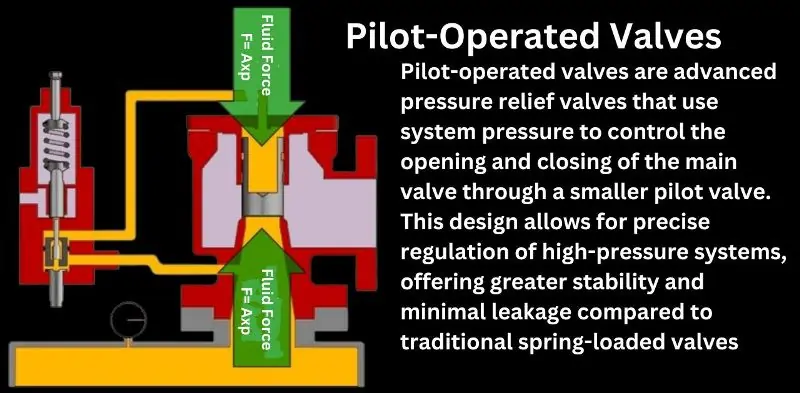
Pilot-operated pressure relief valves are designed for applications that involve high-pressure systems. Unlike spring-loaded valves, which rely solely on mechanical force, pilot-operated valves use system pressure to assist in controlling the valve’s operation. A smaller pilot valve, controlled by the system pressure, regulates the opening and closing of the main valve. This design allows pilot-operated valves to manage much higher pressures with greater precision and stability than spring-loaded valves. They are particularly useful in industries such as oil and gas, where maintaining precise pressure control in pipelines and processing equipment is critical. The ability to handle high pressures with minimal leakage and reduced wear makes pilot-operated valves ideal for demanding applications.
Thermal Relief Valves
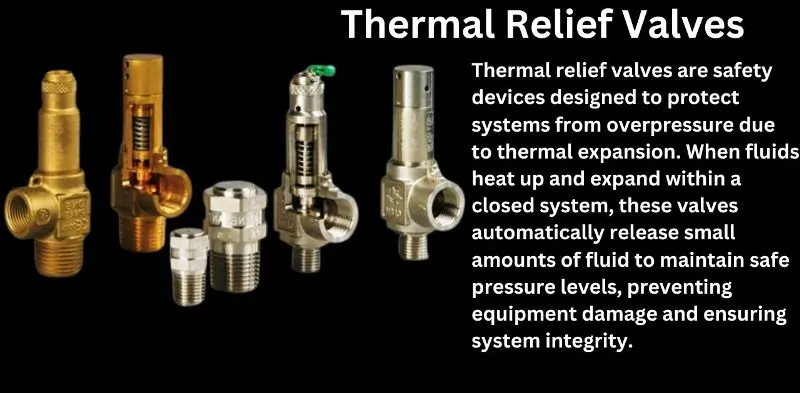
Thermal relief valves are specifically designed to protect systems from the dangers of thermal expansion. When fluids are heated, they expand, potentially increasing pressure within a closed system beyond safe levels. Thermal relief valves respond to this by releasing small amounts of fluid to prevent overpressure conditions caused by thermal expansion. These valves are commonly used in systems where temperature fluctuations are frequent, such as in refrigeration units, hot water systems, and hydraulic circuits. By automatically relieving pressure, thermal relief valves play a crucial role in preventing damage to equipment and ensuring the safety of the overall system in applications where thermal expansion is a concern.
Installation Best Practices for Pressure Relief Valves
Proper Placement
- Strategic Positioning: Install pressure relief valves at points where pressure is most likely to accumulate, such as near pumps, compressors, or other pressure-generating equipment.
- Accessibility: Ensure the valve is placed in a location that allows for easy access during maintenance and inspections.
- Enhanced Responsiveness: Correct placement enhances the valve’s ability to respond quickly and effectively to overpressure, ensuring the entire system is protected.
Avoiding Common Installation Mistakes
- Alignment: Ensure the valve is properly aligned with the piping to prevent leaks or reduced efficiency. Secure all connections to avoid misalignment.
- Proximity: Avoid placing the valve too far from pressure build-up areas, which can delay response time and reduce effectiveness.
- Correct Sizing: Use the correct size and type of valve for the specific application to ensure adequate pressure relief.
- Manufacturer Guidelines: Always follow the manufacturer’s installation guidelines and consult with an expert if there is uncertainty regarding the correct valve selection or placement.
Proper installation is key to maximizing the safety and efficiency of the system.
Maintenance and Inspection of Pressure Relief Valves
Routine Checks
Regular maintenance and inspection of pressure relief valves are crucial to ensure their reliability and optimal performance. Routine checks help identify potential issues before they lead to system failures. This includes verifying that the valve operates correctly, inspecting for signs of corrosion or blockage, and ensuring that all components are functioning as intended. Regular maintenance not only extends the life of the valve but also enhances the safety and efficiency of the entire system. A well-maintained pressure relief valve is essential for preventing overpressure incidents that could result in costly downtime or catastrophic failures.
Signs of Wear and Tear
During inspections, it’s important to look for specific signs of wear and tear that may indicate a need for valve replacement. Common indicators include corrosion, material degradation, leaks around the valve seat, and sluggish valve operation. Additionally, any noticeable changes in the valve’s performance, such as delayed opening or failure to reseat properly, are clear signs that the valve may be nearing the end of its service life. Understanding these signs and responding promptly can prevent system failures and ensure that the pressure relief valve continues to operate effectively.
Wear Detection Formula
To calculate the time required to detect significant wear on a valve, the following formula can be applied:

This formula helps in estimating when wear and tear might become significant, allowing for timely maintenance or replacement of the valve. Regularly applying this calculation as part of your maintenance routine ensures that you can predict and prevent potential issues before they compromise system safety.
Troubleshooting Common Issues
| Issue | Identification | Resolution |
|---|---|---|
| Leakage and Blockages | Signs: Fluid leakage around the valve, reduced flow, or valve not sealing properly. Causes: Blockage due to debris, corrosion, or wear in valve components. | Resolution: Inspect and clean the valve regularly to remove debris. Replace worn or corroded parts. Ensure proper alignment during reassembly. |
| Pressure Settings Issues | Signs: Valve opens or closes at incorrect pressure levels, inconsistent system pressure. Causes: Incorrect calibration, spring wear, or setting drift over time. | Resolution: Recalibrate the valve using manufacturer’s guidelines. Adjust the spring tension or replace it if worn. Regularly test and adjust the set pressure to maintain accuracy. |
Regulatory Standards and Compliance for Pressure Relief Valves
Industry Standards
Pressure relief valves are subject to stringent industry standards and regulations to ensure their safety and effectiveness across various applications. Key standards include those set by organizations such as the American Society of Mechanical Engineers (ASME), the National Board of Boiler and Pressure Vessel Inspectors, and the International Organization for Standardization (ISO). These standards govern the design, manufacturing, testing, and installation of pressure relief valves to ensure they perform reliably under specified conditions. For example, ASME Section VIII provides comprehensive guidelines for the construction of pressure vessels and the pressure relief valves used to protect them. Compliance with these standards is not only a legal requirement but also a critical factor in maintaining system safety and operational integrity.
Ensuring Compliance
To ensure that your systems meet all necessary standards, it is essential to follow a few key steps. First, select pressure relief valves that are certified and tested according to the relevant industry standards. Make sure that the valves are appropriate for the specific application, considering factors such as pressure, temperature, and the type of fluid being controlled. Regular inspections and maintenance should be conducted to verify that the valves are functioning correctly and have not been compromised by wear, corrosion, or other factors. Documentation is also crucial; keep detailed records of all valve installations, inspections, and maintenance activities to demonstrate compliance during audits or inspections.
Compliance Formula
To calculate the required pressure that meets safety standards for your system, use the following formula:
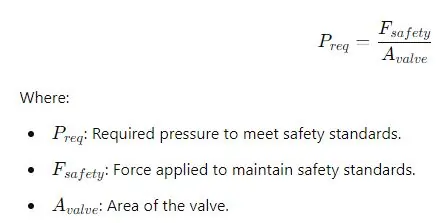
This formula helps in determining whether the pressure relief valve installed in your system is capable of maintaining safety according to the applicable standards. By ensuring that the calculated pressure aligns with the regulatory requirements, you can confidently maintain compliance and ensure the safety of your operations.
FAQ on “Pressure Relief Valve”
Q: What is the primary function of a pressure relief valve?
A: It prevents overpressure by releasing excess fluid from the system.
Q: How often should pressure relief valves be inspected?
A: They should be inspected regularly, ideally during routine maintenance.
Q: Can a pressure relief valve be adjusted?
A: Yes, the set pressure can be adjusted to meet specific system requirements.
Q: What industries commonly use pressure relief valves?
A: They are commonly used in oil and gas, chemical processing, and HVAC systems.
Conclusion
In this post, we’ve explored seven critical insights into pressure relief valves, covering their basic operation, key design considerations, types, installation best practices, maintenance, troubleshooting, and regulatory compliance. Understanding these aspects, along with the essential formulas related to valve performance, is crucial for ensuring the safety and efficiency of high-pressure systems.
By applying these insights and formulas, you can optimize the operation of pressure relief valves in your systems, prevent potential failures, and maintain compliance with industry standards. Proper knowledge and application of these principles are key to safeguarding your equipment and enhancing overall system reliability.
